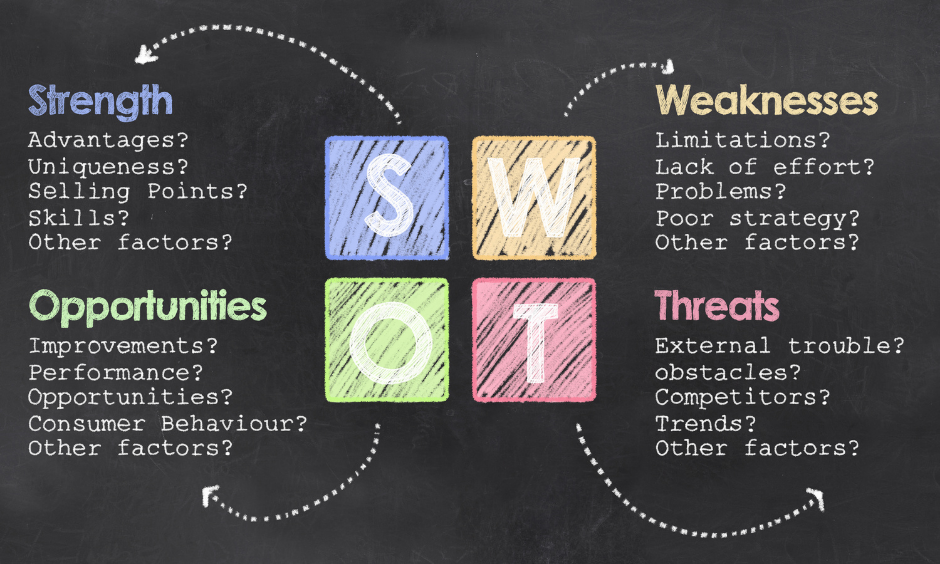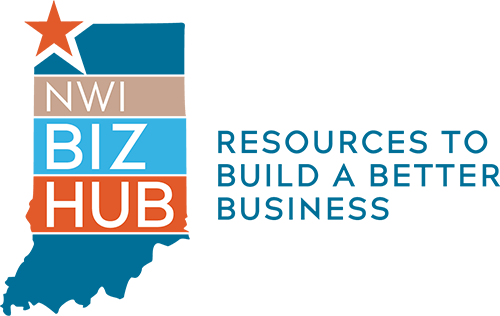
A growth plan is very similar to a business plan, however a business growth plan focuses on the expansion of your business and how to achieve your newly set goals.
Audit your business
Driving your business to the next level requires an assessment of your current business.
To begin your business assessment, conduct a SWOT analysis to identify your organization’s strengths, weaknesses, opportunities, and threats.

A SWOT analysis is a very simple, yet powerful tool to help you develop your business strategy.
Strengths and weaknesses are internal to your company. These are the things you have some control over and can change. Examples include who is on your team, uniqueness, and location.
Opportunities and threats are external to your company. These are things that are going on outside of your company, in the larger market, that you cannot control. Examples include competitors, prices of raw materials, and customer shopping trends.
Paul Schoemaker from The Mack Institute, recommends starting your SWOT analysis with your opportunities and threats.
Tips on Examining Opportunities and Threats
- Keep your focus on the outside world (not yourself). How is it changing and why? Don’t forget to cover key forces, including social, technological, economic, and environmental drivers.
- Discourage fragmentary thinking. Adopt a systems view.
- Be honest about what you can’t predict about the future: list major external uncertainties and discuss how they might unfold.
- Assess which external changes you missed in the past and why. Are you any better this time around? If so, why?
Tips on Examining Strengths and Weaknesses
- Think about core competencies rather than physical or intellectual assets.
- Depict your business model visually with arrows and feedback loops, showing how various capabilities interact and relate to your revenue/profit model.
- Labeling something as a strength or weakness implies a reference point. Decide what yours is. Is it more past, present, or future oriented?
- Include soft issues in your assessment, such as culture, organizational climate, leadership capacity, etc.
Creating a five-year business plan
A growth strategy involves more than envisioning your long-term success. A growth plan includes expansion opportunities, marketing plan, and demographics of your market area.
Rob Biederman, Co-Founder and CEO of Catalant, stated that developing a growth strategy is not a one-size-fits-all process. That’s not to say you cannot learn from another company. You need to adapt a plan to smooth your business’s inefficiencies, refine its strengths and better suit your customers.
Seven key steps to a growth strategy that works immediately
- Establish a value proposition: For your business to be sustainable, you must understand what sets you apart from the competition. Identify why your customers come to you for a product or service.
- Identify your ideal customer: You originally started your business to solve a problem for a certain audience – who is that audience? Is that audience your ideal customer? If not, who are you serving? Nail down your ideal customer, and revert back to this audience as you adjust business to stimulate growth.
- Define your key indicators: Changes must be measurable. If you are not able to measure a change, you don’t have a way of knowing if it is effective. Identify which key indicators affect the growth of your business, then dedicate time and money to those areas.
- Verify your revenue streams: What are your current revenue streams? What revenue streams could you add to make your business more profitable? Are these new revenue streams sustainable?
- Look to your competition: No matter what industry you are in, your competition is likely excelling at something that your company is struggling with. Don’t be afraid to ask for advice.
- Focus on your strengths: Sometimes, focusing on your strengths, rather than trying to improve your weaknesses, can help you establish growth strategies.
- Invest in talent: Your employees have direct contact with your customers, so you need to hire people who are motivated and inspired by your company.
We’re here to help – Let’s work together!
Guide: Grow Your Business


